-
08-21-2023
Percepciones, maltrato y religión como predictores del impacto psicoemocional en enfermeros durante la pandemia COVID-19
Revista Brasileira de Enfermagem. 2023;76(3):e20220768
Abstract
Percepciones, maltrato y religión como predictores del impacto psicoemocional en enfermeros durante la pandemia COVID-19
Revista Brasileira de Enfermagem. 2023;76(3):e20220768
DOI 10.1590/0034-7167-2022-0768es
Views0See moreRESUMEN
Objetivos:
analizar la relación entre percepciones, maltrato y religión con el impacto psicoemocional en enfermeros durante la pandemia por covid-19.
Métodos:
estudio transversal descriptivo-analítico. Fue realizado entre los años 2020 y 2021; se encuestó a 319 enfermeros asistenciales de Perú mediante DASS-21; se evaluaron asociaciones mediante Rho de Spearman y regresión múltiple.
Resultados:
el 18,5 % presentó algún grado de estrés; el 50,2 %, ansiedad y el 29,1 %, depresión. La experiencia de maltrato, la autopercepción de la salud mental y la religión fueron predictores de estrés, ansiedad y depresión. El tiempo de experiencia laboral predice el estrés y ansiedad. Además, la autopercepción de la información y el género fueron predictores de la depresión.
Conclusiones:
los enfermeros peruanos presentaron altos niveles de estrés, ansiedad y depresión; y este impacto psicoemocional estuvo asociado a las percepciones, experiencias de maltrato y la religión.
-
ORIGINAL ARTICLE08-21-2023
Identity dimension of rural women and the sexual and reproductive health
Revista Brasileira de Enfermagem. 2023;76(3):e20220298
Abstract
ORIGINAL ARTICLEIdentity dimension of rural women and the sexual and reproductive health
Revista Brasileira de Enfermagem. 2023;76(3):e20220298
DOI 10.1590/0034-7167-2022-0298
Views0See moreABSTRACT
Objectives:
to analyze the social representations of rural women about being a woman in the rural context and its implications for sexual and reproductive health.
Methods:
this is a descriptive qualitative study with data triangulation, based on the Theory of Social Representations, developed with 31 women who live in the rural context of Minas Gerais (MG/BR). An in-depth interview with a semi-structured script was conducted. A lexical analysis was performed with the help of the ALCESTE 2012 software.
Results:
the family relationship, especially the couple’s, demonstrated subjectivities and was permeated by violence and normalized sexual practice. The imagery dimension of the ideal family seems to be responsible for exerting domination over rural women.
Final Considerations:
rural women are subject to the norms and prescriptions of a patriarchal society. It is urgent to increase attention to sexual and reproductive health in an egalitarian and liberating way in order to minimize the consequences of machismo and conservatism.

-
ORIGINAL ARTICLE08-11-2023
Agreement with COVID-19 disinformation among Portuguese-speaking older adults: an international study
Revista Brasileira de Enfermagem. 2023;76:e20230091
Abstract
ORIGINAL ARTICLEAgreement with COVID-19 disinformation among Portuguese-speaking older adults: an international study
Revista Brasileira de Enfermagem. 2023;76:e20230091
DOI 10.1590/0034-7167-2023-0091
Views0See moreABSTRACT
Objectives:
to assess agreement with COVID-19 disinformation among Portuguese-speaking individuals aged 50 years or older.
Methods:
a descriptive and analytical study involving 1,214 older adults born in Portuguese-speaking countries. Data collection occurred through online information mining to recognize COVID-19 and disinformation content, and the application of a structured questionnaire.
Results:
agreement with disinformation content was 65.2%. Residing outside Brazil is a protective factor for agreement with disinformation content, and those who believe in the truthfulness of the information sources they receive were 31% more likely to agree with disinformation content.
Conclusions:
there is a high prevalence of disinformation among the older population in two Portuguese-speaking countries, which should raise the attention of healthcare professionals and guide coping strategies.
-
ORIGINAL ARTICLE08-07-2023
The relationship of general, physical, and psychological violence with depressive symptoms and cognition in elders (cross-sectional study)
Revista Brasileira de Enfermagem. 2023;76(3):e20220375
Abstract
ORIGINAL ARTICLEThe relationship of general, physical, and psychological violence with depressive symptoms and cognition in elders (cross-sectional study)
Revista Brasileira de Enfermagem. 2023;76(3):e20220375
DOI 10.1590/0034-7167-2022-0375
Views0See moreABSTRACT
Objectives:
to analyze the relationship of general, physical, and psychological violence with depressive symptoms and cognition in the elderly.
Methods:
quantitative, cross-sectional study, carried out with 323 elders from the Brazilian northeast. Data collection used a sociodemographic instrument; the Conflict Tactics Scales Form R; the Geriatric Depression Scale; and the Mini-Mental State Examination. The analysis employed descriptive and inferential statistics.
Results:
as violence increases, so do the depressive symptoms; the opposite was true when comparing violence with cognitive involvement. There is a correlation between physical and psychological violence and depressive symptoms; more depressive elders are from 1.96 to 3.00 times more likely to be the victims of psychological and physical violence, respectively.
Conclusions:
general, physical, and psychological violence is associated with depressive symptoms; those with less cognitive alterations are more vulnerable to abuse. Elders with depressive symptoms are more likely to suffer psychological and physically violence.
-
ORIGINAL ARTICLE08-07-2023
Professional burnout and patient safety culture in Primary Health Care
Revista Brasileira de Enfermagem. 2023;76(3):e20220311
Abstract
ORIGINAL ARTICLEProfessional burnout and patient safety culture in Primary Health Care
Revista Brasileira de Enfermagem. 2023;76(3):e20220311
DOI 10.1590/0034-7167-2022-0311
Views0See moreABSTRACT
Objectives:
to analyze the association between the risk of occupational exhaustion (burnout) and safety culture in Primary Health Care.
Methods:
ross-sectional study conducted in 18 Primary Health Care Units in the Northeast of Brazil. Three questionnaires were used: sociodemographic, Maslach Burnout Inventory, and the Medical Office Survey on Patient Safety Culture. The study was approved by the Research Ethics Committee.
Results:
seventy-eight healthcare workers participated, of which 64.1% presented a reduced risk of burnout; and 11.5%, a high risk (p=0.000). The following were identified as weakened dimensions of safety culture: Work pressure and pace; Owner, managing partners, leadership support; Overall ratings on quality; and Overall rating on patient safety.
Conclusions:
an association was found between low risk of developing burnout syndrome and positive evaluation of safety culture.
-
ORIGINAL ARTICLE08-07-2023
Systematization of Nursing Care: how did the concept mature?
Revista Brasileira de Enfermagem. 2023;76(3):e20220464
Abstract
ORIGINAL ARTICLESystematization of Nursing Care: how did the concept mature?
Revista Brasileira de Enfermagem. 2023;76(3):e20220464
DOI 10.1590/0034-7167-2022-0464
Views0See moreABSTRACT
Objectives:
to analyze the Systematization of Nursing Care conceptual maturation from the perspective of pragmatic utility.
Methods:
a concept analysis study. The stages were: select the concept; elaborate analytical questions; comprehensively review the literature; and determine concept structural components. Sixty-one documents were analyzed after a search carried out until October 2019.
Results:
four temporal periods of contextual changes have occurred since the emergence of ideas of a systematization in the 1960s. This first lasted until 1990. It was followed by those from 1990 to 2002, from 2002 to 2009 and from 2009 onwards. Partial conceptual maturity was identified, operationalization over the years, based on multiple definitions, and, currently, a concept of Systematization of Nursing Care with managerial and organizational attributes.
Conclusions:
the concept of Systematization of Nursing Care is partially mature, presents multiple definitions, being operationalized in uncertain connections with other concepts.
-
ORIGINAL ARTICLE08-07-2023
King’s Parkinson’s Disease Pain Questionnaire: reliability and convergent construct validity
Revista Brasileira de Enfermagem. 2023;76(3):e20220379
Abstract
ORIGINAL ARTICLEKing’s Parkinson’s Disease Pain Questionnaire: reliability and convergent construct validity
Revista Brasileira de Enfermagem. 2023;76(3):e20220379
DOI 10.1590/0034-7167-2022-0379
Views0See moreABSTRACT
Objectives:
to assess the evidence of reliability and convergent construct validity of the King’s Parkinson’s Disease Pain Questionnaire.
Methods:
psychometric study of 75 older adults with Parkinson’s disease. The instrument was applied by two researchers separately and reapplied by one researcher 15 days later. In terms of reliability, internal consistency was assessed using the Cronbach’s alpha test and stability using the intraclass correlation coefficient. Scores of the King’s Parkinson’s Disease Pain Questionnaire were compared to those of the Geriatric Pain Measure in the assessment of construct validity.
Results:
the mean Cronbach’s alpha obtained between the three assessments was above 0.60, the intraclass correlation between the three assessments was above 0.90, and there was a weak but significant correlation between the two applied scales.
Conclusions:
the instrument showed adequate evidence of convergent construct validity and reliability, and can be used in clinical practice.
-
ORIGINAL ARTICLE08-07-2023
Construction and validity of the Interprofessional Communication in Health Scale
Revista Brasileira de Enfermagem. 2023;76(3):e20220483
Abstract
ORIGINAL ARTICLEConstruction and validity of the Interprofessional Communication in Health Scale
Revista Brasileira de Enfermagem. 2023;76(3):e20220483
DOI 10.1590/0034-7167-2022-0483
Views0See moreABSTRACT
Objectives:
to construct and validate the Interprofessional Communication Scale in Health.
Methods:
a psychometric study was carried out on a sample of 360 nurses from a hospital and university center in central Portugal. Reliability was assessed through internal consistency and construct validity through exploratory and confirmatory factor analysis.
Results:
the Interprofessional Communication in Health Scale, consisting of 27 items, is organized into 3 factors: “Teamwork”, “Conflict management” and “Leadership”, with a total variance of 51.1%. Good internal consistency was obtained, with a Cronbach’s alpha of 0.842, and adequate Goodness of Fit Index model.
Conclusions:
the Interprofessional Communication in Health Scale presents a factorial structure with adequate validity and reliability results, and may constitute a useful self-report instrument in assessing interprofessional communication in health.
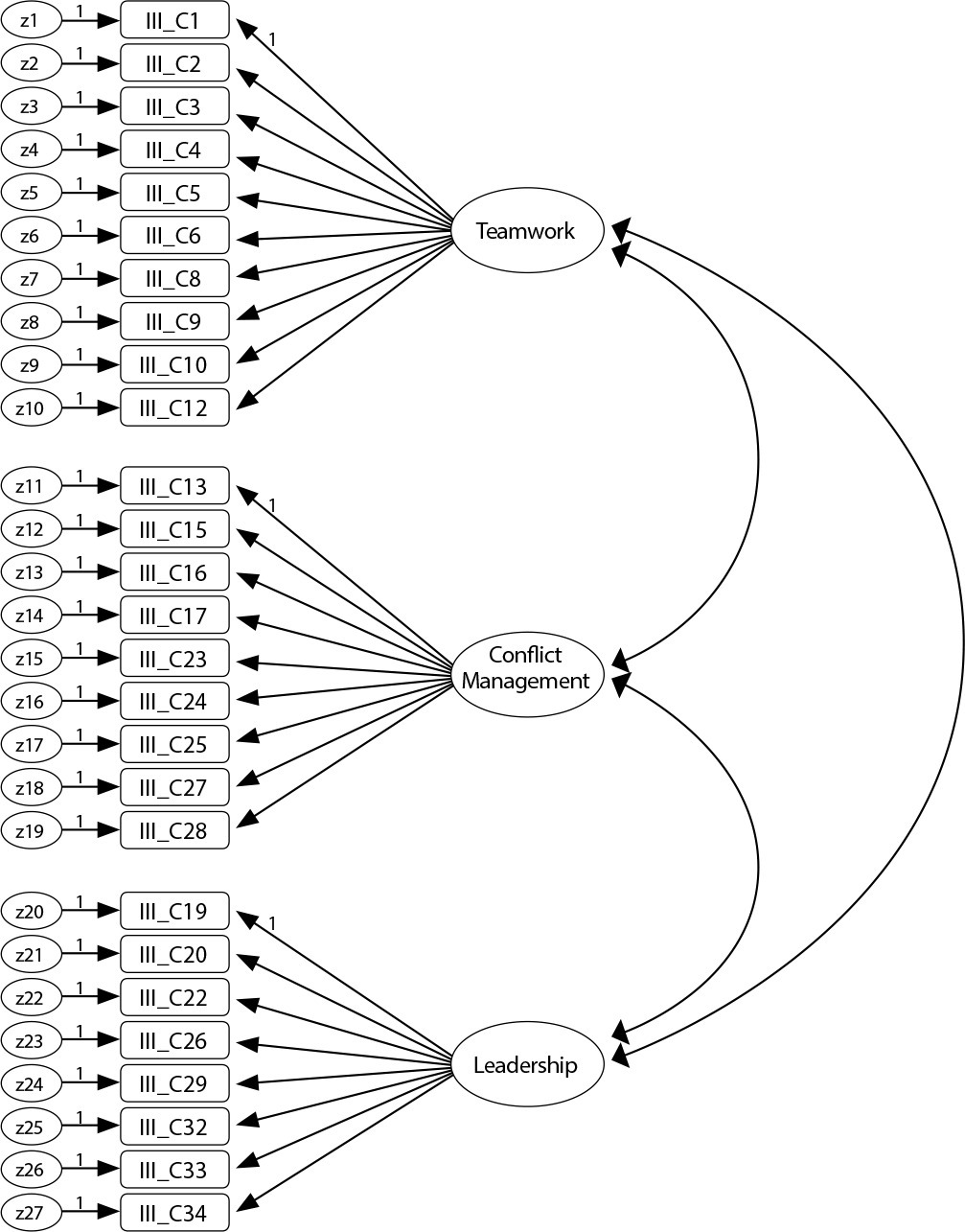
-
ORIGINAL ARTICLE10-28-2020
Conflict management strategies used by Portuguese nurse managers
Revista Brasileira de Enfermagem. 2020;73:e20190336
Abstract
ORIGINAL ARTICLEConflict management strategies used by Portuguese nurse managers
Revista Brasileira de Enfermagem. 2020;73:e20190336
DOI 10.1590/0034-7167-2019-0336
Views0See moreABSTRACT
Objectives:
to analyze the perception and conflict management strategies used by nurses in the management of people in Portuguese health services.
Methods:
descriptive, correlational study, carried out in Portuguese health services, with an intentional non-probabilistic sample, totaling 95 nurse managers. A questionnaire and Conflict Management Scale were used, analyzing the variables of managerial activities and conflict management, with the aid of software.
Results:
it was identified that 60% of the managers, report having to mediate conflicts daily, and the majority report adopting dialogue in conduct. However, through the Kruskal-Wallis test, it was shown that enforcement strategies in conflict management prevail (p = 0.008), with collaborative ones being more restricted to monthly intervals (p = 0.049).
Conclusions:
managers perceive the importance of collaboration in the mediation of conflicts, however, in their daily lives; they tend to maintain imposing behaviors, signaling for a little transformational leadership style.
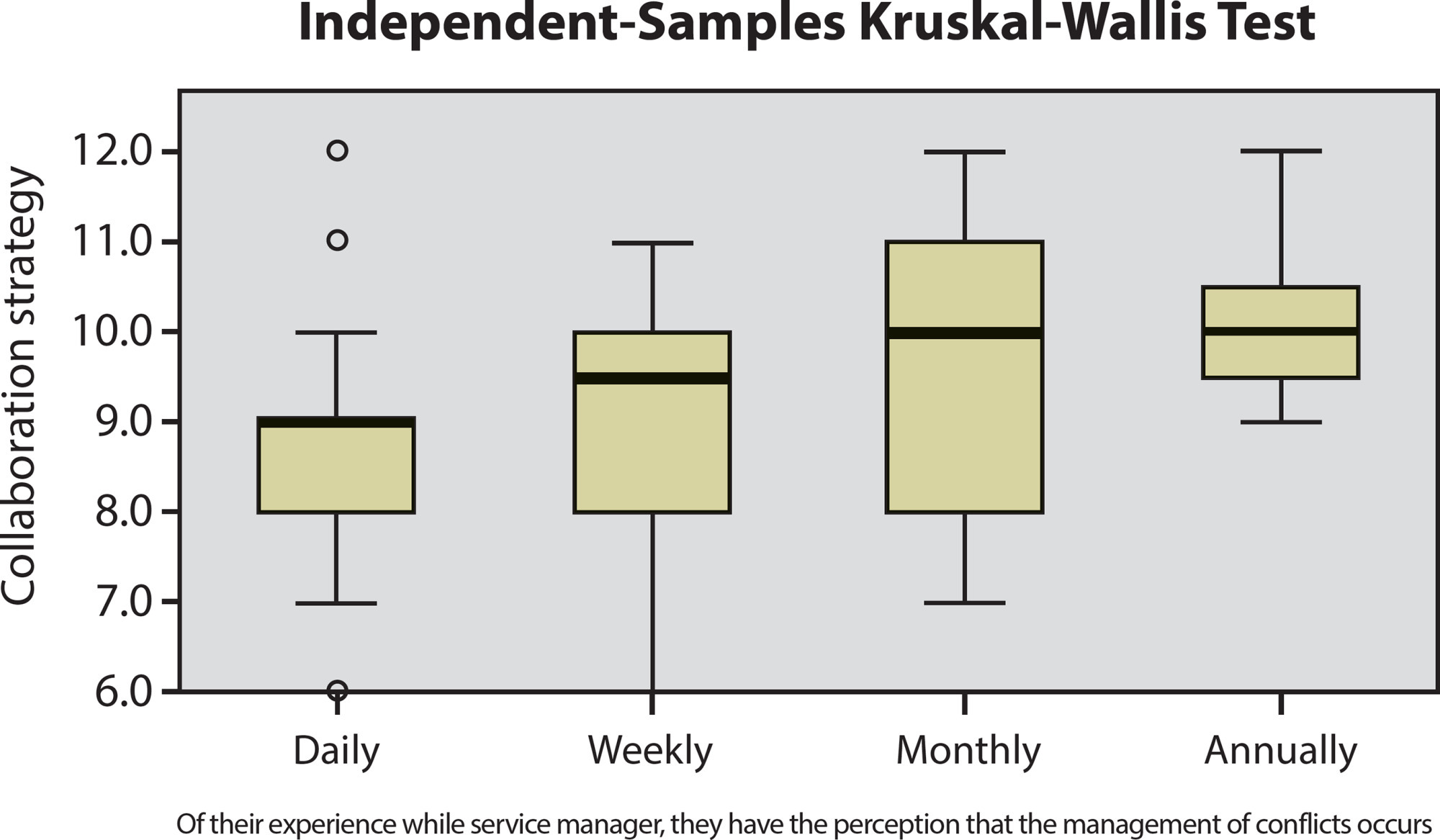
-
ORIGINAL ARTICLE10-01-2022
Frailty in the elderly: screening possibilities in Primary Health Care
Revista Brasileira de Enfermagem. 2022;75(2):e20200973
Abstract
ORIGINAL ARTICLEFrailty in the elderly: screening possibilities in Primary Health Care
Revista Brasileira de Enfermagem. 2022;75(2):e20200973
DOI 10.1590/0034-7167-2020-0973
Views0See moreABSTRACT
Objectives:
to evaluate two instruments for screening frailty in the elderly in Primary Health Care.
Methods:
this is an observational, cross-sectional study, with a quantitative approach, with 396 elderly people. SPSS software helped to perform the statistical analyses. The study used the kappa coefficient and Spearman’s correlation.
Results:
the kappa coefficient between the Clinical-Functional Vulnerability Index 20 and the Edmonton Frailty Scale was 0.496, considered moderate. There was a positive and significant correlation (r = 0.77; p < 0.001) between the frailty conditions and the total score of the two instruments.
Conclusions:
when this article assessed fragility through the kappa coefficient, both instruments presented positive correlation and agreement. However, the identification of frailty was higher when it used the Edmonton Frailty Scale.
-
ORIGINAL ARTICLE09-16-2019
Knowledge of nursing student on the prevention of sexually transmitted infections
Revista Brasileira de Enfermagem. 2019;72(5):1145-1152
Abstract
ORIGINAL ARTICLEKnowledge of nursing student on the prevention of sexually transmitted infections
Revista Brasileira de Enfermagem. 2019;72(5):1145-1152
DOI 10.1590/0034-7167-2017-0801
Views0See moreABSTRACT
Objective:
To identify the knowledge and self-care actions taken by nursing undergraduate students of a Federal University of the South of Brazil, against Sexually Transmitted Infections.
Method:
Exploratory qualitative study, conducted 40 interviews with undergraduate students at the beginning and end of the course. The analysis was thematic, resulting in three categories.
Results:
Knowledge about the subject is a decisive factor for self-care, and the more knowledge, the greater the prevention. The dissemination of knowledge of students at the end of the course not only influences self-care but also health promotion in the social sphere.
Final considerations:
Knowledge is important in self-care and caring for others. The dissemination of knowledge becomes evident according to the complexity of the course. Stable relationships may interfere with the use or disuse of condoms in sexual relationships, a misnomer present in today’s society.
-
ORIGINAL ARTICLE03-30-2020
Meanings assigned by families about children’s chronic disease diagnosis
Revista Brasileira de Enfermagem. 2020;73(2):e20180742
Abstract
ORIGINAL ARTICLEMeanings assigned by families about children’s chronic disease diagnosis
Revista Brasileira de Enfermagem. 2020;73(2):e20180742
DOI 10.1590/0034-7167-2018-0742
Views0See moreABSTRACT
Objectives:
to understand the meanings assigned by family caregivers about children’s chronic disease diagnosis.
Methods:
qualitative study, which used as theoretical framework the Symbolic Interactionism, and methodological, the Grounded Theory. It was held in a pediatric unit in Southern Brazil, in 2016, through interviews submitted to open and axial analysis, with the participation of 20 family caregivers of hospitalized children.
Results:
relatives, interacting with the nursing/health staff, perceive children’s disease at birth. They are diagnosed with chronic disease by the physician and deny it. Subsequently, they accept and seek information on care.
Conclusions:
the results pointed out the stages that relatives experience by assigning meanings to about children’s chronic disease diagnosis. These meanings provide subsidies for nurses’ actions, which need to be aware of children’s and family’s needs in order to offer comprehensive and humanized care.
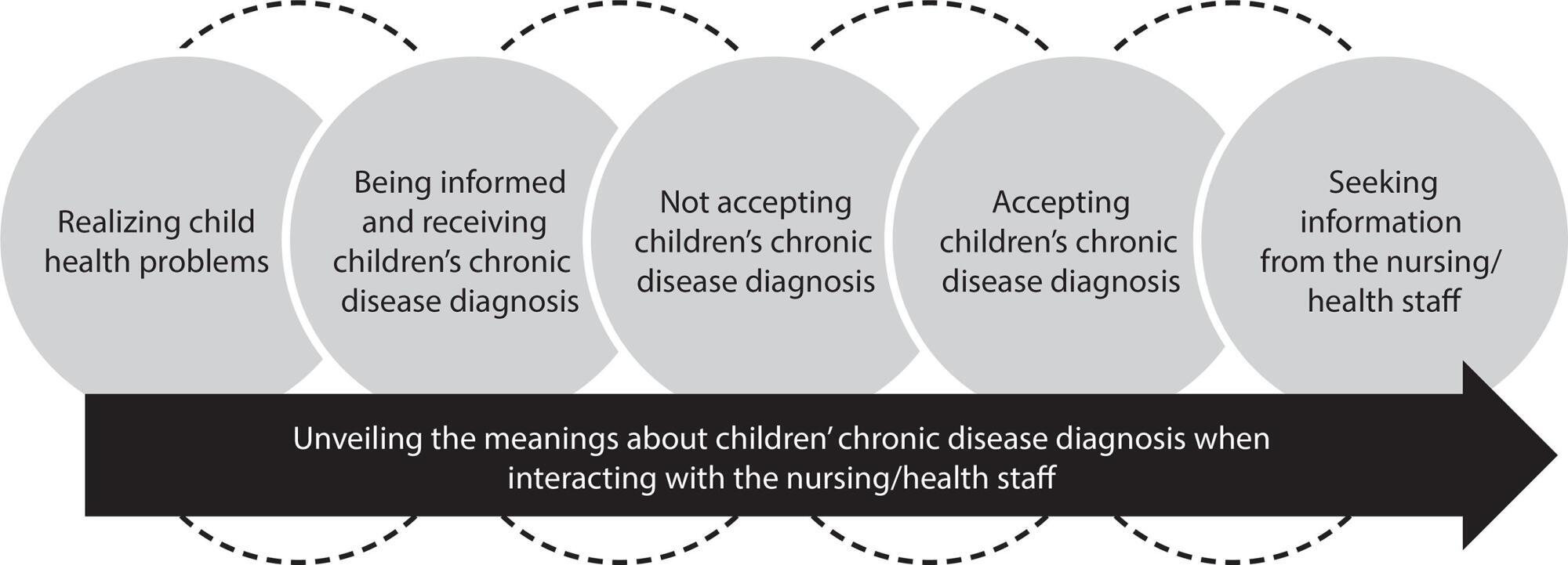
-
03-09-2020
Psychiatric nursing and mental health teaching in relation to Brazilian curriculum
Revista Brasileira de Enfermagem. 2020;73(2):e20180200
Abstract
Psychiatric nursing and mental health teaching in relation to Brazilian curriculum
Revista Brasileira de Enfermagem. 2020;73(2):e20180200
DOI 10.1590/0034-7167-2018-0200
Views0See moreABSTRACT
Objectives:
to know the scientific production on psychiatric nursing and mental health teaching in relation to Brazilian nursing curriculum.
Methods:
an Integrative Literature Review with no temporal delineation, whose data collection took place in ten Brazilian and international databases, adding to the total 35 objects of analysis.
Results:
a priori categories were adopted, consisting of the psychiatric nursing and mental health teaching in Brazil according to the 1923, 1949, 1962, 1972, 1994 and 2001 nursing curriculum, presented in the light of the dimensions: thought model; places of practice; methods or contents used; and profile or skills of the student.
Final considerations:
the study made it possible to observe psychiatric nursing and mental health teaching historical evolution, indicating that teaching transformations involved changes in curriculum, Psychiatric Reform and the way nursing undergraduate courses and schools take these determinants.
-
08-19-2019
Professional education on dementias in Primary Health Care: an integrative review
Revista Brasileira de Enfermagem. 2019;72(4):1086-1093
Abstract
Professional education on dementias in Primary Health Care: an integrative review
Revista Brasileira de Enfermagem. 2019;72(4):1086-1093
DOI 10.1590/0034-7167-2018-0652
Views0See moreABSTRACT
Objective:
To investigate the most commonly used educational approaches in dementia training for primary health care professionals.
Method:
Integrative literature review, conducted between April and June of 2018, in PubMed, LILACS and IBECS databases. The descriptors used were: Training, Health Personnel, Dementia, Primary Health Care for PubMed; and the MeSH terms, Training Programs, Health Personnel, Dementia, and Primary Health Care for LILACS and IBECS.
Results:
The sample consisted of 13 articles; eight were published in the last five years (62%); seven articles with a quantitative approach (54%); seven articles produced on the European continent (54%), followed by five published on the North American continent (38%). All journals were from the health area (100%).
Conclusion:
Educational strategies were combined and used for education. Significant improvements in knowledge, skills, and attitudes of the teams with regard to professional management of dementias were evidenced.
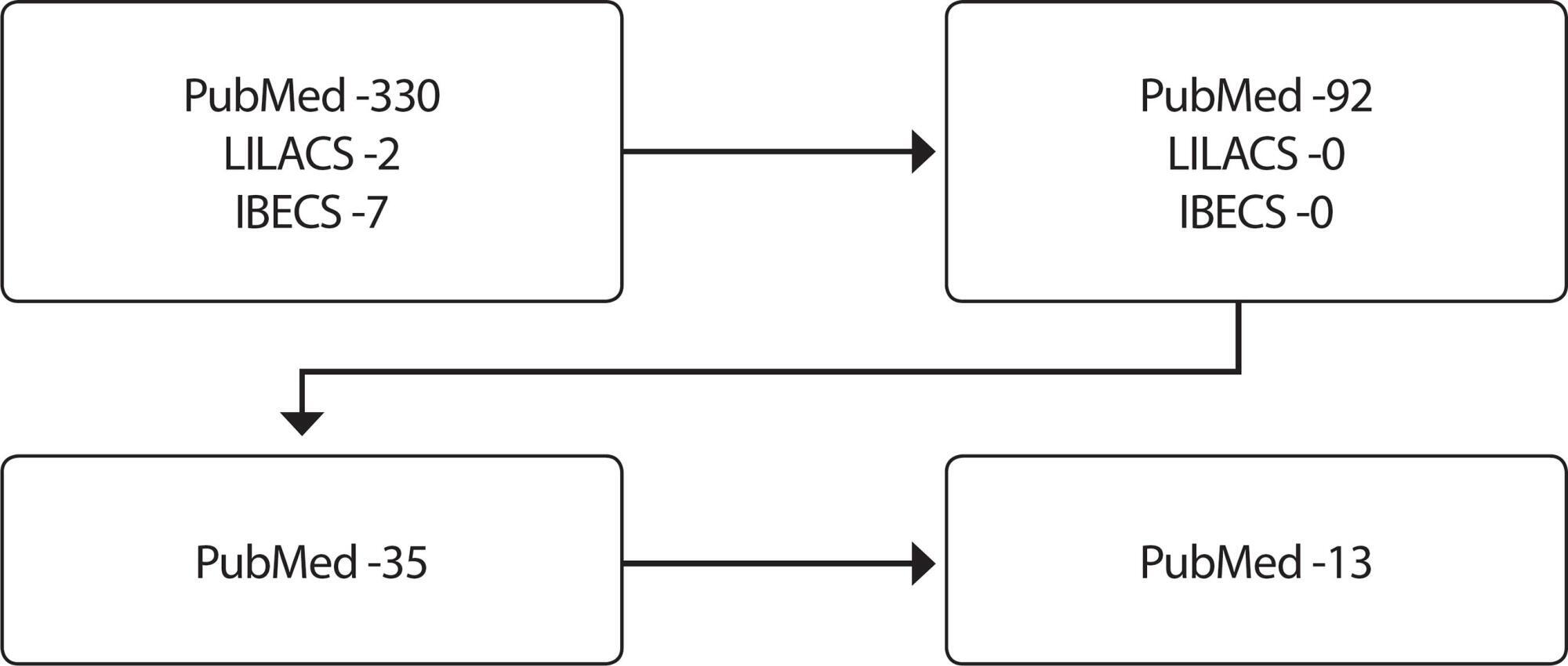
-
05-21-2021
Quality of life and falls in elderly people: a mixed methods study
Revista Brasileira de Enfermagem. 2021;74:e20200400
Abstract
Quality of life and falls in elderly people: a mixed methods study
Revista Brasileira de Enfermagem. 2021;74:e20200400
DOI 10.1590/0034-7167-2020-0400
Views0See moreABSTRACT
Objective:
to assess elderly people’s quality of life, understanding the social representations of falls.
Methods:
a convergent mixed methods research carried out at homes, with a sample of 134 elderly people. A structured questionnaire was used, covering sociodemographic variables and factors that indicated frailty and risk of falling. For quality of life assessment, Medical Outcomes Study Short-Form 36 and Theory of Social Representations, Abric’s structural approach were used, with data treated by dictionary of equivalent terms, processed in Evoc 2000, converging analytically according to Neuman.
Results:
quality of life impairment was identified in terms of physical, emotional and functional capacity. The elements of the possible central nucleus were fall, fear, and bruised-broken-bone.
Final considerations:
quality of life impairment can contribute to increase the number of falls, which has been shown to be an event present in elderly people’s lives through evocations. Understanding elderly people’s individual demands allows planning actions.
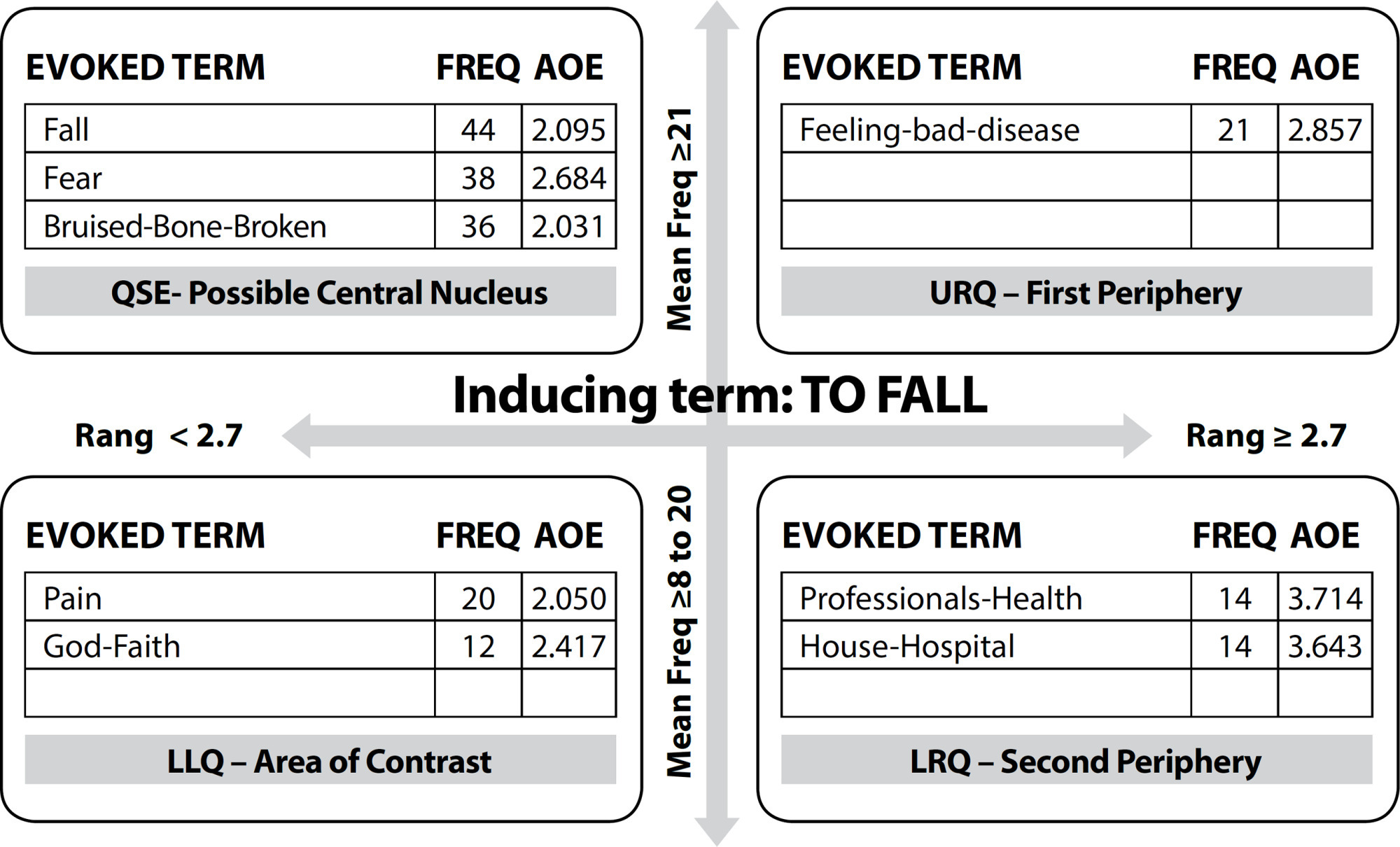
-
ORIGINAL ARTICLE07-08-2020
Patient safety: perception of family members of hospitalized children
Revista Brasileira de Enfermagem. 2020;73(5):e20190525
Abstract
ORIGINAL ARTICLEPatient safety: perception of family members of hospitalized children
Revista Brasileira de Enfermagem. 2020;73(5):e20190525
DOI 10.1590/0034-7167-2019-0525
Views0See moreABSTRACT
Objectives:
to know the meaning attributed by family members to the health safety of pediatric patients, with attention to the possibilities of their collaboration.
Methods:
this qualitative study was conducted with eighteen family members of children hospitalized in a pediatric unit, from January to July 2018. Symbolic Interactionism was used as a theoretical framework, and Inductive Content Analysis as method.
Results:
child hospitalization poses risks to possible incidents and adverse events. Participants and professionals are responsible for patient safety. Thus, their actions focus on error prevention. Therefore, they seek information and observe in a vigil way professional care in classic aspects of safety. They conceive essential and favoring safety the approach centered on children and family members.
Final Considerations:
family members recognized the chances of errors and care damage, identified themselves as support in minimizing damage and were in partnership with the professional, increasing chances of effecting safety.
Search
Search in:
Nuvem de Tags
Adolescente (85) Atenção Primária à Saúde (239) COVID-19 (91) Criança (91) Cuidados de Enfermagem (269) Educação em Enfermagem (151) Educação em Saúde (139) Enfermagem (930) Enfermagem Pediátrica (86) Estudantes de Enfermagem (77) Estudos de Validação (131) Família (87) Idoso (208) Promoção da Saúde (99) Qualidade de Vida (104) Saúde do Trabalhador (86) Saúde Mental (145) Saúde Pública (82) Segurança do Paciente (150) Tecnologia Educacional (100)



